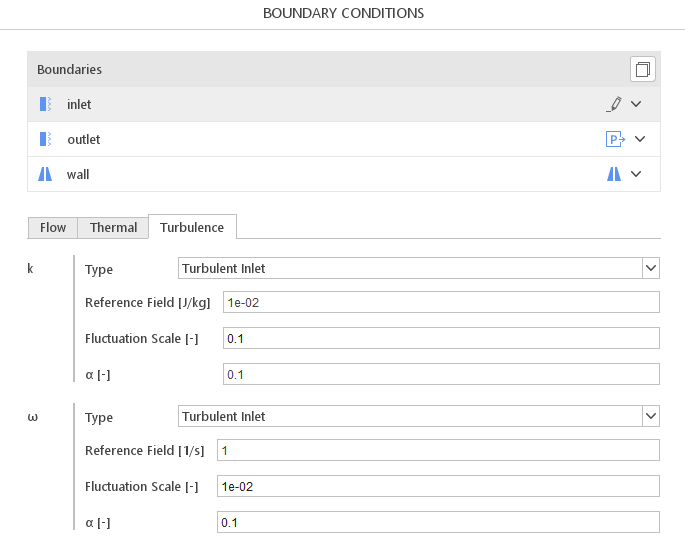Turbulent Inlet - Boundary Condition Description
turbulentInlet is the boundary condition used to model the inflow conditions for a turbulent flow field. It is specifically designed to generate a spatially varying and time-varying turbulent field at the inlet boundary of a computational domain - generates a fluctuating inlet condition by adding a random component to a reference (mean) field. The boundary condition can be applied to any type of variable, e.g.: scalar, vector, etc.
At a specific moment, each component is increased by the same random number. For example, the velocity components (u, v, w) are each increased by the random number, p, resulting in the output (u+p, v+p, w+p).
It is not recommended to utilize the turbulentInlet boundary condition as a turbulent velocity inflow condition for DES or LES computations. Despite its misleading historical name, the boundary condition does not generate turbulence-like time-series and quickly diminishes downstream of the inlet boundary. Therefore, turbulentInlet should be used with transient RANS simulations only.
Turbulent Inlet - Boundary Condition Application & Physical Interpretation
The turbulentInlet boundary condition models the inflow with predefined turbulence characteristics. In physical terms, this means that instead of assuming a uniform or laminar flow entering the domain, the flow possesses fluctuations and chaotic variations typical of turbulent flows. This is critical for accurately capturing the effects of turbulence on flow dynamics, such as mixing, heat transfer, and drag, from the very beginning of the simulation domain.
turbulentInlet in Environmental Flows applications
This problem can be solved by using the bouyantBoussinesqPimpleFoam (solver). In simulations involving atmospheric boundary layers, such as the dispersion of pollutants in urban environments or the flow over complex terrains, the turbulentInlet condition is used to mimic the natural atmospheric turbulence at the boundary of the computational domain.
| Physics | Velocity | Pressure | Thermal T |
|---|---|---|---|
Turbulent Inlet | turbulentInlet | Fixed Flux Pressure | turbulentInlet |
Pipe and Nozzle Flows
pimpleFoam (solver) can be applied for simulations where fluids are injected through pipes or nozzles into larger bodies (e.g., combustion chambers or reactors), turbulentInlet conditions are used to represent the turbulence level of the fluid coming from industrial processes or natural phenomena.
| Physics | Velocity | Pressure |
|---|---|---|
Turbulent Inlet | turbulentInlet | Fixed Flux Pressure |
Turbulent Inlet - Boundary Condition How to apply turbulentInlet in SimFlow
The definition of boundary conditions in SimFlow is both simple and intuitive. To specify the turbulentInlet boundary condition, the user must navigate to the Boundary Conditions panel, select the appropriate boundary, and choose the correct option from the drop-down menu.
To define the turbulentInlet, the proper option must be selected from a drop-down menu. Once selected, the user must provide the following information:
- Reference field - mean-field, for example, mean velocity of the flow
- Fluctuation Scale - RMS fluctuation scale (fraction of mean)
- \(\alpha\) - fraction of new random component added to previous (the default value is 0.1)

Turbulent Inlet - Boundary Condition turbulentInlet - Alternatives
In this section, we propose boundary conditions that are alternative to Turbulent Inlet. While they may fulfill similar purposes, they might be better suited for a specific application and provide a better approximation of physical world conditions.
| Boundary Condition | Description |
|---|---|
Mapped Inlet | inlet conditions mapped from the other boundary of the mesh |
Turbulent Intensity Inlet | provides estimation of turbulent properties, such as \(k\), \(\epsilon\) and \(\omega\) based on turbulence intensity \(I\) |
Turbulent Mixing Length Inlet | inlet conditions mapped from the other boundary of the mesh |